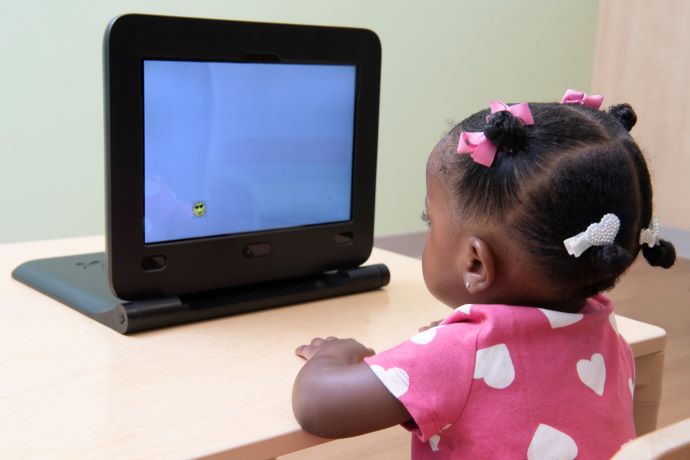New Eye-Tracking Tablet Tool Can Help Diagnose Autism in Children
Atlanta researchers have developed eye-tracking technology, enabled via a tablet, that can aid in detecting autism among children as young as 16 months.

Source: Children's Healthcare of Atlanta
- Atlanta-based researchers have developed a biomarker-based, eye-tracking diagnostic tool to diagnose autism spectrum disorder.
Ami Klin, PhD, and Warren R. Jones, PhD, of Marcus Autism Center, a Children's Healthcare of Atlanta subsidiary, developed the EarliPoint Evaluation technology. The Food and Drug Administration has authorized the tool for use in children between 16 and 30 months.
The technology includes a portable tablet on which children watch videos of social interaction. The device monitors their "looking behavior" to pinpoint the social information the children are looking at and the information they are not looking at, according to the press release.
Clinicians review the data collected by the device, including a personalized report with visualizations from the test. Following review, they can provide pediatric patients and their families with a diagnosis and measures of the child's individual abilities, including social disability, verbal ability, and non-verbal learning skills. From there, the press release notes that clinicians can work with the family on a customized treatment plan.
According to Klin, director of the Marcus Autism Center and division chief of autism and developmental disabilities at Emory University School of Medicine, the tool collects data 120 times per second. Thus, "within 12 minutes of video watching, we can compare moment-by-moment looking behavior of a child and measure thousands of divergencies to compare to typically developing peers," she said in the press release.
Studies evaluating the technology were published last week in the Journal of the American Medical Association (JAMA) and JAMA Network Open.
The study in JAMA aimed to assess the performance of the eye-tracking measurement of social visual engagement compared to clinical diagnosis in young children. The study participants included 499 children, 16 to 30 months old, enrolled at six specialty centers in the United States from April 2018 through May 2019. The clinic's staff used automated devices to measure social visual engagement via eye-tracking. The staff were blind to clinical diagnoses.
Eye-tracking measurement of social visual engagement was successful in the vast majority (95.2 percent) of the children.
Of the 499 children in the study, 221 had autism, and 254 did not, per expert clinical diagnosis. In all children, the measurement of social visual engagement had a sensitivity of 71 percent and specificity of 80.7 percent. Among the 335 children whose autism diagnosis was certain, the sensitivity of the measurement was 78 percent, and the specificity was 85.4 percent.
The other study, published in JAMA Network Open, details the development of the eye-tracking technology and the evaluation of the tool's ability to aid in early diagnosis and assessment of autism in children younger than 3 years.
The researchers conducted two prospective, consecutively enrolled, double-blind studies to develop an objective eye-tracking-based index test for children aged 16 to 30 months. They compared the test's performance with reference standard diagnosis of autism in a discovery study and replicated findings in an independent sample.
The eye-tracking tests were administered to 1,089 children enrolled in the study between April 27, 2013, and September 26, 2017.
Researchers found that in the discovery study, the test had an area under the receiver operating characteristic curve of 0.90, with a sensitivity of 81.9 percent and specificity of 89.9 percent.
In the replication study, the area under the receiver operating characteristic curve of the test was 0.89, sensitivity was 80.6 percent, and specificity was 82.3 percent.
Further, the eye-tracking test results correlated with expert clinical assessments of children's individual levels of ability.
"If diagnosed earlier, child and family supports can also happen earlier. Earlier supports help children by capitalizing on greater neuroplasticity at younger ages. Currently, only one in four children with autism is identified before age three. Our hope is that this tool can help alleviate this enormous public health challenge with earlier diagnoses and treatment," said Jones, lead author of the studies, director of research at Marcus Autism Center, and the Nien Distinguished Chair in Autism at Emory University School of Medicine, in the press release.
